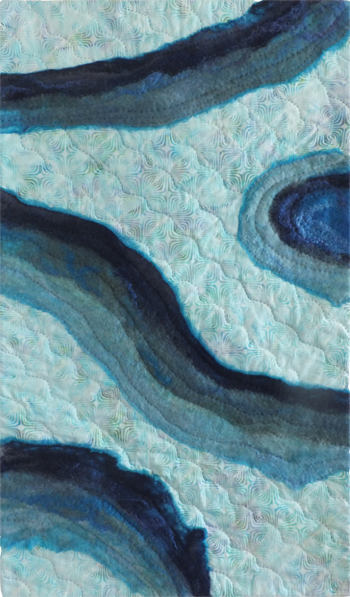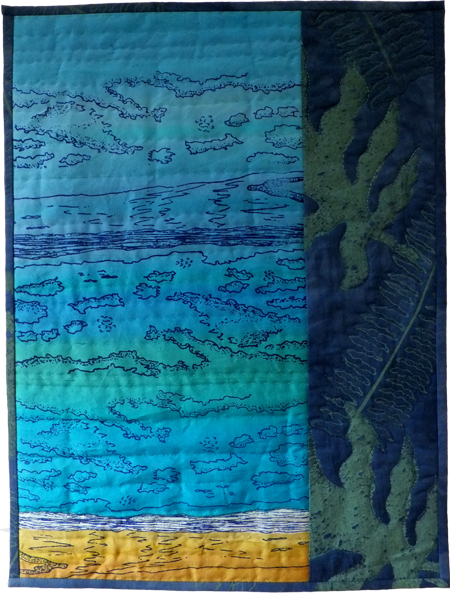The theme for my 2013 Journal Quilts -
Oceania: Arts & Crafts of the Pacific.
This ‘Sea of Islands’ links many diverse cultures, from Australia & New Zealand through Melanesia, Micronesia and Polynesia. How romantic and exotic these places sound, and indeed they are!
Last August I had the opportunity to visit an Aboriginal village in the Kakadu, Northern Territory of Australia, and meet the ‘makers’ keeping their traditions alive. In Fiji I found a woman who demonstrated the art of stencilling on Tapa bark cloth. Hidden away in the Vaults of the British Museum, and on display at the Pitt Rivers in Oxford are a wealth of artefacts that tell their stories. It’s going to be such fun, bringing these to life.
Journal Quilts this year are 12" x 8" (30.5 x 20.3cm)
|
| |
|
 |
|
January: Sea of Islands
This ‘Sea of Islands’ links many diverse cultures, from Australia and New Zealand through Melanesia, Micronesia and Polynesia. Rebecca is currently away from her base in Queensland on one of these tiny specks, Palau, running workshops for the fishing community.
I used silver gutta on a finely woven silk to mark the outlines of larger islands and appropriate dots to represent the smaller ones. I then applied a colour wash of silk dye over the gutta. The island names are free quilted in a fine cotton. |
|
|
| |
|
|
| |
 |
| |
February: Navigation
Sailing for fishing or exploration remains a key feature of the Pacific Islanders culture.This kind of chart, designed and made by each navigator, is unique to the Marshall Islands. Made from palm leaf ribs and shells, it was used as a mnemonic device before setting sail into open sea; the position of swells, currents and islands are recorded here.
Stencilling, corded quilting and surface embellishment on textured raw silk.
|
| |
|
 |
|
March: Fishing
In a remote part of Fiji we watched as a lone fisherman fished for our supper and then bargained with the cook to get his price! This ornately decorated float can be seen in the British Museum and is from the Soloman Islands, where Rebecca is currently working to conserve the fish stocks.
Bonded applique, painted dupion, dyed cotton and natural bark cloth.
|
|
|
| |
|
|
| |
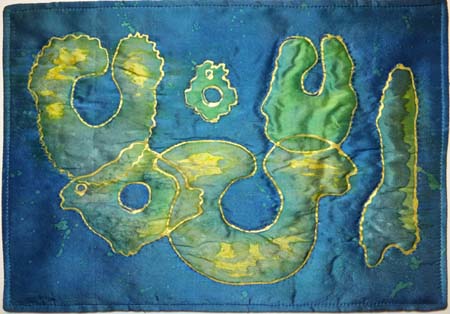 |
| |
April: Pounamu
A fabulous collection of Pounamu (nephrite) from the west coast of South Island, New Zealand.Te Papa Museum in Wellington has a wonderful gallery of these beautiful green stones. Notched edges were particularly valued and the hei tiki (neck pendants) are still popular today.
Layers of silk painting and wax resist, hand quilted with silk wadding and backed with chiffon.
|
| |
|

|
|
May: Tapa Cloth
In Fiji making and decorating tapa or barkcloth is women’s work, men must bring the tea and cook on that day .The paints are made by boiling mangrove roots. This sticky viscous liquid is mixed with charcoal to get the dark browns and with grated local clay to get the rusty reds. Traditionally stencils were made from banana leaf. For my version , I used freezer paper leaf stencils and a wood block for the border. Markal paintsick on silk –linen slub.
|
|
|
| |
|
| |
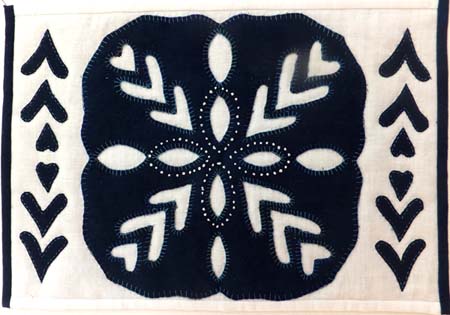 |
| |
June: Blue Papercut
Quiltmaking was introduced to the Pacific Islands in the C19, but the Islanders made their own patterns, exploring symmetry with imagery of flowers and fruits. As a social craft activity, this has begun to replace making tapa cloth. I used mistyfuse for this version, fine blue cotton on white linen.
|
| |
|
|
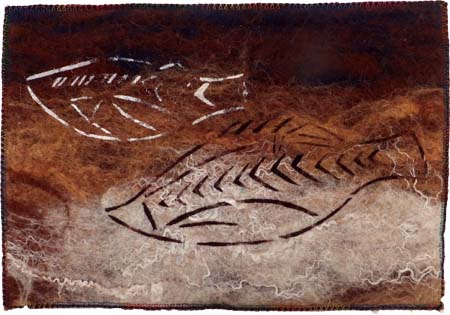 |
|
July: Kakadu Wall
A magical morning guided among the rock paintings above the Aborigine settlement at Oenpelli in the Arnhemland Aboriginal Reserve, Kakadu National Park, NT, Australia. New paintings are often applied over older ones, creating a mystical layering effect. We bought mementos here at Injalak Arts; a painting, a fish trap basket and some screen printed fabric.
Felted fibres including Merino, English wool and banana fibres. Stencilled with printing inks and hand quilted.
|
|
|
| |
|
| |
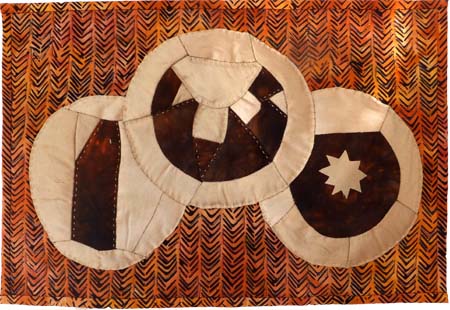 |
| |
August: Ivory and Pearl
Whale Ivory and Pearl shell were used to make these ceremonial breastplates in the South Pacific Islands, conveying status to the tribal chiefs rather than real protection. Sections were stitched in the same manner as for making canoes, on the reverse side, so that the stitching does not show.
Mine are pieced over papers in a similar manner, using tea dyed silk and dyed sateen, and mounted on a vibrant fabric print. |
| |
|
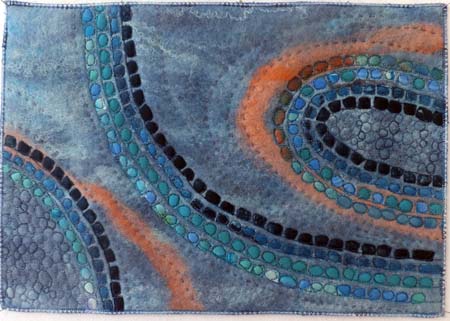 |
|
September: The Coral Sea
Flying low over the Fijian Islands , glorious blues and greens radiate from the reef. Wool fibres felted onto chiffon make a background for mosaic bonded silk applique. Continuing to explore how these techniques can work together.
|
|
|
| |
|
| |
 |
|
October: Wood Carving
Wood carving is a popular form of decoration on canoes, tools and shields. Geometric patterns are woven here with the morning star, a detail from a dance shield from Bougainville, Soloman Islands.
Printing with opaque white screen ink using blocks and miracle sponge.
|
| |
|
|
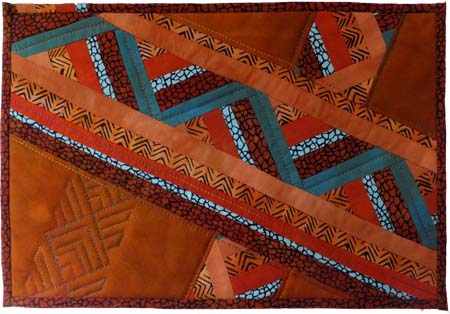 |
|
November: Wood Block
The wood carved decoration on canoes, wooden vessels and ceremonial weapons often follow patterns of strips and stripes, repeated to create harmonious designs. This interpretation is worked in plain and patterned fabric, over -dyed to unify the design.
|
|
|
| |
|
| |
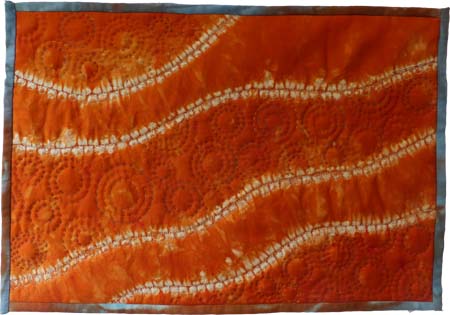 |
| |
December: Rhythmic Circles
In the Kakadu National park, the Northern Territory I was able to visit an Aboriginal village and watch basket makers and painters at work. The style of paintings, the free application of paint and the rhythmic patterns created are compelling. At the current Royal Academy ‘Australia’ show, several contemporary pieces are displayed on floor plinths, appropriate to the way in which they are created and viewed by the makers, and evocative of the inspiration drawn from the landscape.
Circles are often used to mask hidden stories.
I used stitched lines to create resist patterns on cotton sateen, then dyed rust.
|
| |
|
| |
|
|
The Coral Sea
Tasmania Challenge Quilt
48 x 80cm
Flying over the Coral Sea in the Fijian Islands. Ribbons of reef glisten in the sun. Hands up for sustainable fishing!
Hand dyed felted wool and silk fibres applied and quilted with the challenge print fabric. I felt that the subtle grid within the print provided an interesting background to the soft textures and edges characteristic of felt. |
| |
|
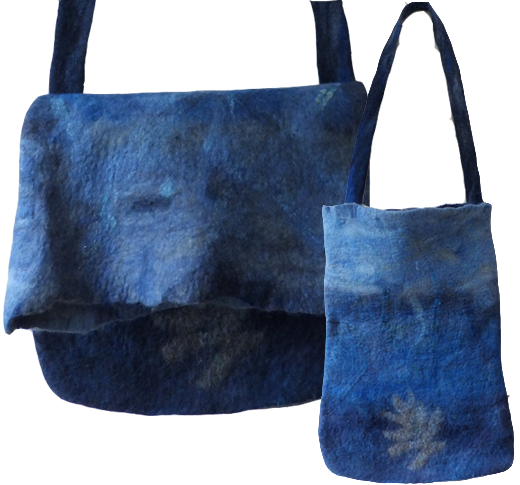 |
Blue Fern Bag.
37 x 50 cm
Robust and practical felt. Felted, stitched and felted again. The design incorporates fern shapes and torn strips of silk to add texture and interest. |
| |
|
|
Coconuts (left)
23 x 107cm
A challenge to use black & white with only a small colour accent. Backgrounds in graded colours of wool felt. Appliqued coconuts in wax resist dyed silk; design is fragmented shapes & layered with wool wadding and machine quilted. Hand quilting on the felted areas.
|
|
Come to the Tropics (right)
30 x 42 cm
Clear blue water, soft golden sand, exotic rain forest. Screen prints and sponge print on cotton and silk, machine quilted.
|
| |
|
| |
|















